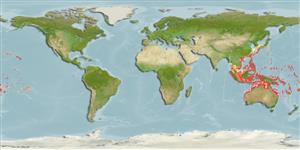>
Eupercaria/misc (Various families in series Eupercaria) >
Labridae (Wrasses) > Corinae
Etymology: Coris: Greek, kore, -es = pupil and also with themenaing of "maid" (Ref. 45335).
More on authors: Quoy & Gaimard.
Environment: milieu / climate zone / depth range / distribution range
Ökologie
seewasser riff-verbunden; tiefenbereich 0 - 50 m (Ref. 1602). Tropical; 37°N - 31°S, 96°E - 142°W
Pacific Ocean: Christmas and Cocos-Keeling Islands in the eastern Indian Ocean to the Society and Tuamoto islands, north to Japan and the Hawaiian Islands, south to Australia. Replaced by Coris cuvieri in the Indian Ocean (Ref. 37816).
Size / Gewicht / Alter
Maturity: Lm ? range ? - ? cm
Max length : 40.0 cm TL Männchen/unbestimmt; (Ref. 2334); common length : 20.0 cm TL Männchen/unbestimmt; (Ref. 27550)
Rückenflossenstacheln (insgesamt): 9; Rückenflossenweichstrahlen (insgesamt): 12-13; Afterflossenstacheln 3; Afterflossenweichstrahlen: 12. Juveniles easily recognized by their striking coloration. Females have a bright yellow caudal fin (Ref. 48636).
A solitary species (Ref. 90102) found in areas of mixed coral, sand and rubble of exposed outer reef flats, lagoon and seaward reefs (Ref. 1602, 48636). Benthopelagic (Ref. 58302). Feeds mainly on mollusks, crabs, and hermit crabs, and occasionally on tunicates and forams (Ref. 1602). Minimum depth reported taken from Ref. 128797.
Life cycle and mating behavior
Geschlechtsreife | Fortpflanzung | Ablaichen | Eier | Fecundity | Larven
Oviparous, with distinct pairing during breeding (Ref. 205).
Randall, J.E., 1999. Revision of the Indo-Pacific labrid fishes of the genus Coris, with descriptions of five new species. Indo-Pac. Fish. (29):74 p. (Ref. 33411)
IUCN Rote Liste Status (Ref. 130435)
Bedrohung für Menschen
Reports of ciguatera poisoning (Ref. 4690)
Nutzung durch Menschen
Fischereien: kommerziell; Aquarium: Öffentliche Aquarien
Mehr Information
ReferenzenAquakulturAquakultur ProfilZuchtlinienGenetikElectrophoresesVererbbarkeitKrankheitenVerarbeitungNutrientsMass conversion
Tools
Zusatzinformationen
Download XML
Internet Quellen
Estimates based on models
Preferred temperature (Ref.
123201): 24.3 - 29, mean 27.9 °C (based on 690 cells).
Phylogenetic diversity index (Ref.
82804): PD
50 = 0.5000 [Uniqueness, from 0.5 = low to 2.0 = high].
Bayesian length-weight: a=0.00977 (0.00470 - 0.02030), b=3.07 (2.89 - 3.25), in cm total length, based on LWR estimates for this (Sub)family-body shape (Ref.
93245).
Trophic level (Ref.
69278): 3.5 ±0.2 se; based on diet studies.
Widerstandsfähigkeit (Ref.
120179): mittel, Verdopplung der Population dauert 1,4 - 4,4 Jahre. (Preliminary K or Fecundity.).
Fishing Vulnerability (Ref.
59153): Low to moderate vulnerability (30 of 100).
Nutrients (Ref.
124155): Calcium = 35.7 [14.0, 96.2] mg/100g; Iron = 0.552 [0.329, 0.970] mg/100g; Protein = 18.6 [15.7, 20.8] %; Omega3 = 0.128 [0.065, 0.250] g/100g; Selenium = 34 [13, 94] μg/100g; VitaminA = 98.9 [32.3, 339.5] μg/100g; Zinc = 1.85 [0.86, 3.31] mg/100g (wet weight);
